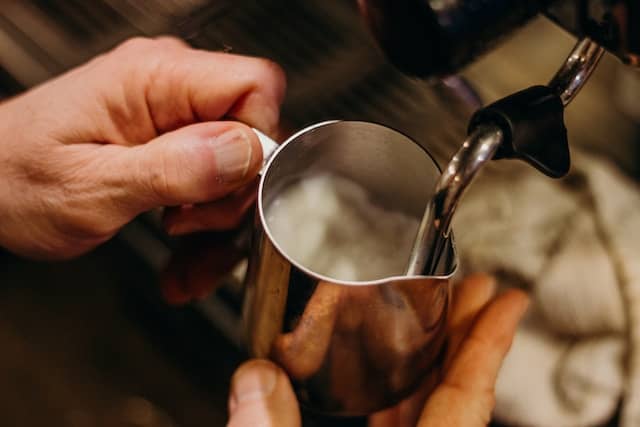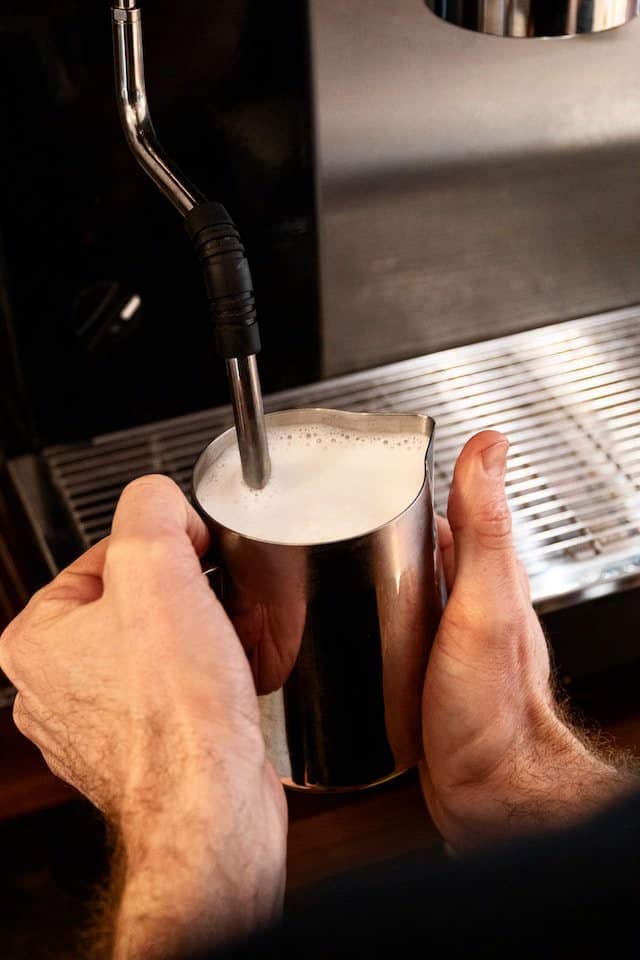Last updated on September 19th, 2023 by Catherine Reed

There are few things in the world that bring me joy quite like an expertly crafted cappuccino, latte, or macchiato. When done right, they have a smooth, creamy texture that’s just impossible to beat.
Fortunately, I (and you!) don’t have to go to a café to get that experience every single day. By learning how to use a milk frother, it’s possible to craft a delectable drink at home.
And the best part? Using a milk frother is pretty simple.
Here’s a guide on milk frothing for beginners, including an overview of what milk frothers do, how to use a milk frother, and more.
What Milk Frothers Do

Photo by Luke Porter
Milk frothers are devices that aerate the milk. When you use a milk frother, you create tiny microbubbles in the milk that gives it a light, creamy texture. The air also increases the volume of the milk a bit as the air gets held in the milk.
Usually, air frothers work one of three ways. First, some may aerate the milk using a pumping action. Second, a milk frother might be essentially a high-speed whisk. Finally, some milk frothers rely on fast-moving steam. But regardless of the approach, the end result is similar, creating light foam that makes coffee drinks so smooth, creamy, and delectable.
How to Use a Milk Frother

Photo by Jackson Schaal
Best Type of Milk to Use
Technically, you can froth any type of milk, but the results do vary depending on what you’re using. Overall, for heated foam, whole milk offers the silkiest experience, as the extra milk fat works in your favor. Half-and-half is also an excellent option, particularly if you like a decadent, rich coffee experience. However, that doesn’t mean you can’t try alternatives. You can test it by trying breve coffee.
For those who consume dairy but prefer less fat, both 2 percent and skim milk will froth. If you avoid dairy, try oat milk instead, as it offers a similar creaminess as you would get from dairy. Soy milk also works pretty well since it has a comparable amount of protein to dairy milk.
However, you can try almond milk, too. It just may be a bit trickier to get right, but with some practice, you can get a light, airy result that’s genuinely delicious.
If you’re trying to make cold foam, you actually want to choose lower-fat alternatives. Skim milk works incredibly well if you consume dairy. If not, choose a thicker dairy-alternative milk. Any type can potentially do, but I usually get the best results from oat milk.
Preparing the Milk
Generally, there’s not much you need to do to prepare the milk. If you’re having a hot coffee drink, then heating the milk to the right temperature is really the only step (besides putting the milk into an appropriate container). However, you only need to do it if the frother you’re using doesn’t handle the heating part for you.
The temperature you want to aim for may vary depending on the type of milk:
- For dairy versions, something in the range of 130°F to 155°F is what you want.
- For nondairy milk, get the temperature close to 145°F to 150°F if you’re using almond or oat milk, or around 135°F if you’re using soy milk.
If your milk frother handles the heating part, then you won’t have to preheat. Similarly, for cold foam, there’s essentially no preparation, as you aren’t trying to heat the milk up. Just put it in the container and prepare to froth.
Step-by-Step Guide to Frothing
How to Use a Frother on an Espresso Machine
If you have an espresso machine with a built-in frother, you want to use the provided container. Additionally, don’t heat the milk in advance, as the frother is part of the steam wand, so it’ll usually add the heat.
Make sure the container is no more than 1/3 full to avoid spillage. Purge the wand to release any remaining water before you begin. Then, insert the wand into the milk, keeping the tip just below the surface, and make sure to hold the container at an angle. Then, froth until you get your desired result.
How to Use a Milk Frother Wand for Coffee
Handheld milk frothers are my go-to option at home, as they’re compact and effortless to use. Simply prepare your milk in a tall container, hold the container at an angle, and turn the frother on. Then, use an up-and-down motion without letting the frother hit the bottom of the container.
Usually, the process takes anywhere from 20 seconds to a bit over a minute, depending on the size of the bubbles you’re after. Once you’re done, tap the container on your counter to release overly large bubbles, and you’re ready to add it to your coffee.
How to Use a Nespresso Milk Frother
The Nespresso Aeroccino line includes automatic milk frothers that are really easy to use. Simply make sure the right whisk is attached (the coil ring for the Aerocinno 3), add up to 120 ml of cold milk, select your temperature, and it’ll do the rest. Usage of cold and chilled milk is essential to some coffee drinks, such as dirty coffee.
Nespresso milk frother not working? We got you!
How to Use a Milk Frother to Make Cold Foam
If you’re making cold foam, you want to use a milk frother that doesn’t add heat. Usually, going with the milk frother handheld wand option outlined above is the simplest choice.
Aside from these directions, we also have tips and alternatives if a milk frother is not available.
Tips and Tricks to Get the Best Results
There are a few tips and tricks that can help you get the best results when frothing milk.
First, make sure the milk you’re using is as fresh as possible. If it’s been sitting in the fridge for a while, you won’t get the same result.
Second, how long you want to froth the milk depends on the type of drink you’re making. Lattes usually have tinier bubbles, so the frothing time is relatively short. If you’re making a cappuccino or macchiato and want café-like results, you’ll need bigger bubbles, so you have to froth for longer.
Cleaning, Maintenance, and Troubleshooting Common Issues

Photo by Simon Takatomi
When it comes to cleaning and maintenance, handheld milk frothers are simple. You can usually fill a cup with water, add some mild dish soap, and turn the frother on to clean it. Then, use clean water to remove soap residue.
For milk-frothing appliances, you’ll want to read the manufacturer’s instructions. Some of these milk frothers have dishwasher-safe parts, while others don’t. Additionally, care recommendations can vary, so reading the directions is essential.
If you need to clean a frother wand on an espresso machine, it’s also best to read the manufacturer’s directions. Generally, you’ll need to purge the wand and wipe it down after every use.
If the wand gets clogged, you may need to remove it (or the tip) and soak it in hot water for at least five minutes. That usually loosens any debris. If it doesn’t, try a specially designed cleaner that’s made for espresso machine wands, as they’ll effectively break down any buildup.
FAQs
Do You Need to Heat Milk Before Frothing?
You do need to heat the milk if you’re using a handheld frother and are preparing a hot drink. For cold foam, heating isn’t necessary. Similarly, if you’re using the frothing wand on an espresso machine or a frothing device that also provides heat, don’t heat the milk in advance.
Do You Froth Milk Before or After Brewing?
If you’re using a handheld milk frother or a separate frothing device, you can prepare your frothed milk before you brew or while the espresso is brewing. Generally, if you’re using a milk frother on an espresso maker, you want to froth your milk before brewing your espresso, as it’s better for the machine and involves less waiting time to get the right temperatures.
How to Use a Milk Frother Wand for Hot Chocolate
Handheld milk frothers are excellent for whipping hot chocolate powder into heated milk. Heat the milk in a suitable container and then add the powder. Then, turn on the frother and use an up-and-down motion to mix it all together.
How to Use a Milk Frother to Make a Latte
Start by frothing your milk using one of the methods outlined above. Next, make your espresso and put it in a cup. Take the frothed milk and pour it slowly into the coffee, aiming for the deepest part of the cup (usually the center). Once about half of the frothed milk is poured, you can speed up.
Coffee Has Never Read This Good!
Sign up for a FREE newsletter to the best home brewing tips and guides
Thank you for subscribing to The Cup Coffee House Crew! There's a surprise in your Inbox 🙂
Something went wrong.
- About the Author
- Latest Posts

Catherine Reed is a freelance writer and coffee enthusiast. She has been a lover of coffee, espresso, and various café-style concoctions for more than 20 years, and enjoys exploring everything the world of coffee has to offer. Whether it’s trying out new coffee technologies or exploring small-batch creations from independent micro-roasters, Catherine is open to any coffee experience, and aims to share everything she’s learned with discerning readers interested in leveling up their coffee game.

